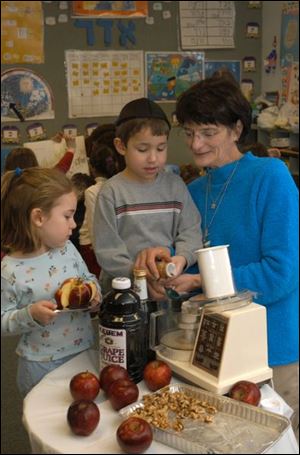
Youngsters learn to prepare Seder meals
3/30/2004As the eight-day celebration Passover approaches (it begins
sundown Monday), Phyllis Wittenberg will prepare the kindergarten
and first-grade classes of David Stone Hebrew Academy in Sylvania
for their Seder meals at home.
Mrs. Wittenberg teaches Judaic studies to the 5 and 6-year-olds.
Many families have their own traditions, she says. Part of the
Seder says to tell the story to your children. There are things that
built into the Seder to keep children interested.
She shows the children how participate in the school s model
Seder. Each grade has their own Seder so parents can see how the
children are growing in knowledge of Passover, she says.
The Seder plate contains symbolic foods needed for retelling
Passover story; it includes a decorative Seder plate, small cups or
ramekins to hold the symbolic foods, and small wine glasses,
which are part of the ceremony.
The foods are parsley or celery leaves (karpas); salt water; a roasted
egg; roasted lamb shank; horseradish or romaine lettuce (maror);
and an apple or a dried fruit, nut, and wine mixture known as
haroset. Matzo is on the table; because bread or any leavening
prohibited at Passover, matzo is needed for both the Seder and
main meal.

Jolie Brochin, 5, holds sliced apple as Matthew Fink, 5, and Phyllis Wittenberg put spice into a food processor.
For the model Seder at school, the kindergarten makes the
haroset, Mrs. Wittenberg says. Haroset symbolizes the mortar
when we were slaves in Egypt.
The youngest students are able slice apples with an apple slicer,
add walnuts, cinnamon, and kosher grape juice, and mix this
a food processor.
They sing a song as they prepare for this task: Apples, nuts, cinnamon, and wine. Chop, chop, chop. It s haroset.
This is a simple food with kids, Mrs. Wittenberg says. Each
child follows the tradition of the Seder by bringing items from
home: a hard-boiled egg, celery (karpas), radish (maror), and a
Passover cookie or macaroon, which is made with no leavening
or flour. We provide the haroset, matzo, and grape juice.
She notes there are both Ashkenazic haroset and Sephardic
haroset (sometimes spelled charoset). Her recipe is similar
Ashkenazic style with apples, nuts, wine, and cinnamon.
The Ashkenazic Seder contains foods from Yiddish-speaking Jews
whose families migrated to America from northern and eastern
European countries between 1880 and 1920, writes Zell Schulman
Let My People Eat!: Passover Seders Made Simple (Macmillan, $27.50).
The Sephardic foods are from Jews from the Mediterranean countries. These were Spanish and Portuguese Jews and those from Turkey, Greece, Italy, and Israel. North African Jews also prepare foods in the Sephardic manner. Ms. Schulman s Sephardic
Charoset includes pitted dates, golden raisins, dark raisins, apple,
sweet wine, orange juice, ground ginger, and blanched slivered
almonds.